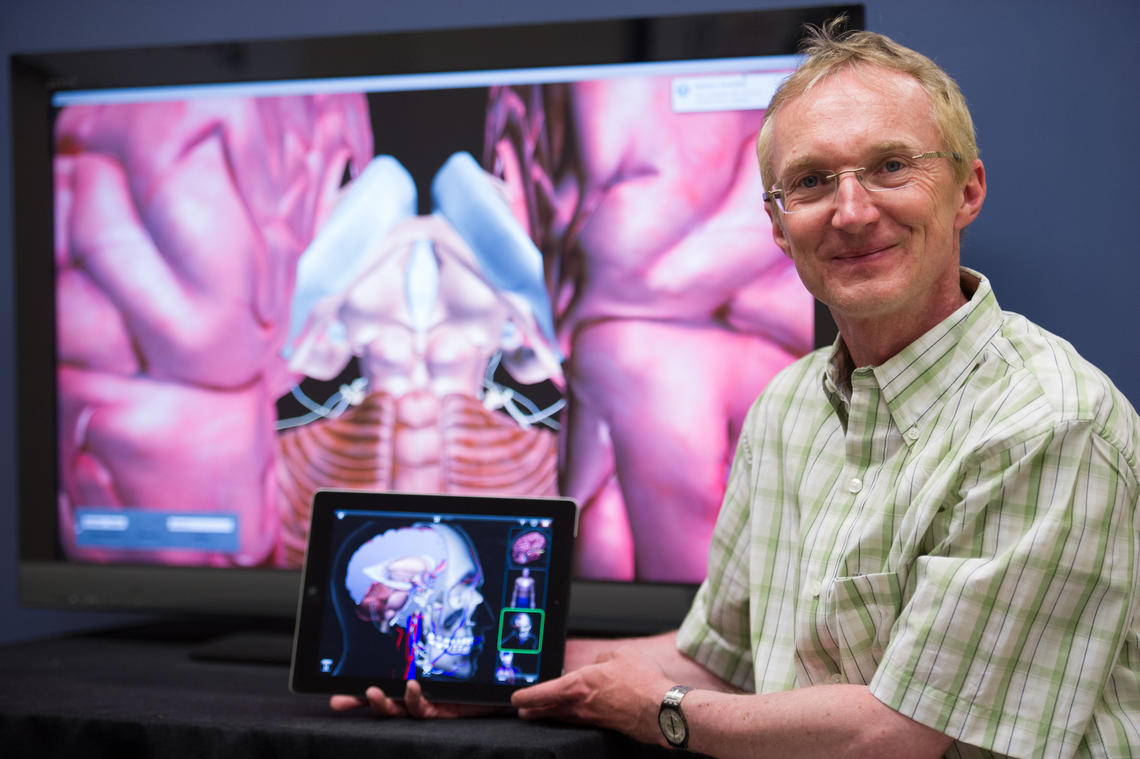
Christian Jacob, co-developer of the app and director of the LINDSAY Virtual Human project.
Riley Brandt, University of Calgary
Feb. 14, 2014

Christian Jacob, co-developer of the app and director of the LINDSAY Virtual Human project.
Riley Brandt, University of Calgary
A University of Calgary app is getting international attention and is being featured at the American Association for the Advancement of Science (AAAS) annual meeting in Chicago today.
The conference brings together experts in computer graphics, engineering, and medicine to discuss future directions in computer-based modeling of humans, and how these computational models and simulations are aiding new discoveries in medicine.
The Lindsay Atlas is a virtual human being used by medical students to learn about anatomy and physiology. The app lets you bring anatomy to life – examining the human body in 3D and dissecting over 3000 body parts.
As one of the app developers, the University of Calgary’s Christian Jacob will be speaking at the AAAS conference. A professor in biochemistry and molecular biology as well as computer science, Jacob is director of bioinformatics and of the LINDSAY Virtual Human project.
Q: What are you speaking about at the conference?
A: At the AAAS conference, I will outline all these aspects of the LINDSAY project and demonstrate how an ecosystem of e-learning tools, such as our LINDSAY software suite, can enhance medical education. After all, education about human anatomy and physiology is the foundation for facilitating further breakthroughs in medicine.
I will speak about the larger scope of the LINDSAY Virtual Human project, through which we are creating interactive 3D computer models to illustrate and explore human anatomy and physiology. The “Zygote Anatomy Atlas & Dissection Lab”, an iPad app, which we created together with Zygote Media Group, is our first product visible outside of the University of Calgary.
On that same website, we have also created the LINDSAY Web Atlas, which offers the same functionality as the iOS app, yet is accessible through a web browser.
The LINDSAY site contains already a number of specimens that have been created for and are already being used in courses in undergraduate medical education in the Faculty of Medicine. Both the Faculty of Kinesiology and the Faculty of Nursing have expressed interest to use our LINDSAY technology for their anatomy classes.
Q: How does this relate to the app you helped develop?
A: The Zygote Anatomy Atlas & Dissection Lab app shows how we can share our tools with the world. We are getting good feedback about this app. What makes our anatomy app special is that one can select specimens and dissect them. For example, one can expose the bones, with some of the muscles peeled back, make certain parts transparent, and add pins with labels, video annotations, or links. In short, one can create highly interactive guided tours through specimens, customized for teaching, learning, and illustrating the complexities of the human body.
Q: Where do you see the future of visualization and education?
A: Highly detailed visualization is now available on mobile device – we can touch, rotate, zoom and explore anatomical structures with ease. The direct interaction through touch immediately gives a better feel for the locations and spatial relationships of anatomical components.
I believe that the next big step is to integrate physiology into such 3D models, so that one can truly observe function. Then comes the challenge to incorporate pathophysiology to illustrate what happens when things go wrong, and how countermeasures — such as medication, physiotherapy, or nutrition — can help to restore or maintain proper function. We and other research groups are working on this, but it’s a long journey.
A first impression of live, computational physiology in the 3D world of a bacterial cell inside a human intestinal tract is shown in one of our videos. Eventually, and this is probably not so far off, we can integrate 3D scans (such as MRI and CT) into our models, so that “personalized medical illustration” is possible.
The project is named after Dr. Lindsay Kimmett, a bright, promising student in undergraduate medical education who died in a car crash. University of Calgary students and faculty members qualify to get the app for free!